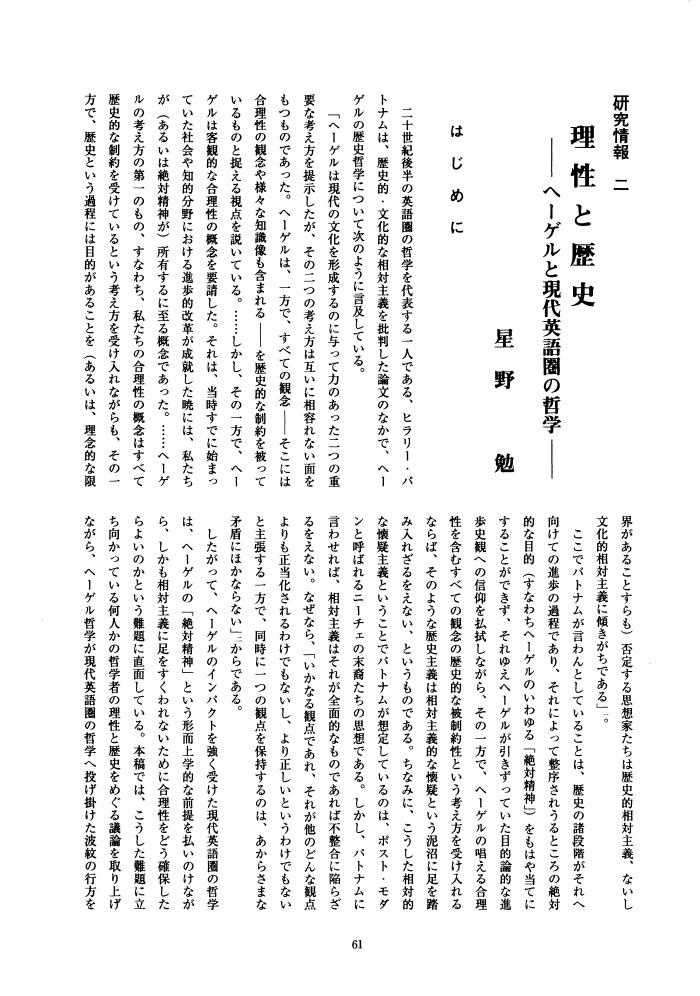本プロジェクトは、医療や環境といった各問題領域ごとバラバラの輸入・紹介から始められた「応用倫理学」を現代日本の文脈に埋め込む作業を通じて、「倫理学におけるマクロ的視点とミクロ的視点の総合」をめざそうとするものであった。初年度開始と同時に総合研究の準備態勢を整え、交付決定後の7月に全体研究打ち合せ会議を開催した。本会議では代表者によって研究目的の詳細な説明がなされた上、二つの報告と活発な意見交換がなされた。12月の全体研究打ち合せ会では、生命倫理、環境倫理、情報倫理の三分野に関する個別報告がなされ、方法論については応用倫理学を「臨床哲学」へと深化・徹底させようとする動向とシステム理論の最前線の議論が紹介された。2月の研究合宿では、生命倫理の難問に即しながら応用倫理学の学問的姿勢を吟味する報告に続いて、研究代表者および分担者が編者を務めた論文集『システムと共同性』の合評会を行なった。最終年度は3会の会議を開催し、全部で11の個別報告と総括がなされた。その大半は別途提出する研究成果報告書や公刊物に掲載されるので、要点のみ列記する。(1)C.テイラー『自我の諸源泉』の検討(星野報告)。(2)公教育における多元文化主義の論争(若松報告)。(3)生命倫理と「公共政策」との連携(平石報告)。(4)〈内在的価値〉の解明(渡辺報告)。(5)環境倫理の再構成(安彦報告)。(6)C・マ-チャント『ラディカル・エコロジー』の吟味(須藤報告)。(7)環境や自然に対する現象学的接近(溝口報告)。(8)阪神大震災後のボランティア・ネットワークの調査(水谷報告)。(9)教育という文化的再生産の機制(壽報告)。(10)討議倫理学の生命倫理への応用(霜田報告)。(11)ビジネス・エシックスのサ-ヴェイ(田中報告)。以上の経過をもって、所期の研究目標はほぼ達成されたものと自己評価を下している。
3 0 0 0 OA 『菊と刀』にみる「恥の文化」
- 著者
- 星野 勉
- 出版者
- 法政大学国際日本学研究所
- 雑誌
- 国際日本学 = INTERNATIONAL JAPANESE STUDIES (ISSN:18838596)
- 巻号頁・発行日
- vol.4, pp.19-37, 2007-03-31
This paper examines, from the perspective of a Japanese researcher, Ruth Benedict's characterization of the culture and behavior patterns of the Japanese as a “shame culture” in her famous The Chrysanthemum and the Sword: Patterns of Japanese Culture (1946).First, I demonstrate that the methodological characteristics of the volume lie in its cultural relativism and comparative perspective. This methodology deconstructs the frameworks on which each culture—in this case Japanese and American—are premised, and by doing so is suggestive of new possibilities for crosscultural understanding.Next, I clarify the way in which Benedict grasped the culture and behavior patterns of the Japanese by analyzing the Japanese sense of ethics as she lays it out in the volume: beginning with chū (fealty to the Emperor) and kō (filial piety), and proceeding through giri (a type of obligation), stoicism (or self-control), sincerity, jichō (self-respect), to haji (shame) and shūyō (self-discipline, mental training). I ascertain that Benedict identified the source of behavior patterns in the concept of “the world” (her translation of seken) and the ideas of social class and order that underlie it, and that, summed up in her phrase “shame culture,” this concept is fundamental to a consistent and coherent understanding of the culture and behavior patterns of the Japanese. Finally, I present a counter argument to those who criticize Benedict for overlooking the autonomous aspect of haji (shame). Indeed, I argue that Benedict should be evaluated more positively for her insight on how haji functions in a way that only appears to be autonomous: she identifies as the primary characteristic of Japanese ethics their tendency toward self-control as a means of avoiding the shame occasioned by committing a breach of what the eyes of “the world” see as an obligation.According to Benedict, “the world” forms a public arena or community for the Japanese that conditions the behavior of the individual. I close this paper with the observation that the accuracy of Benedict's grasp of Japanese culture is demonstrated paradoxically by modern Japanese society, where the breakdown of this sense of community has brought about a state of things where, as the old saying goes, “tabi no haji wa kakisute" (the shame incurred while traveling can be discarded and forgotten).
2 0 0 0 OA 理性と歴史―ヘーゲルと現代英語圏の哲学―
- 著者
- 星野 勉
- 出版者
- 日本ヘーゲル学会
- 雑誌
- ヘーゲル哲学研究 (ISSN:13423703)
- 巻号頁・発行日
- vol.1998, no.4, pp.61-66, 1998-06-11 (Released:2010-07-27)
2 0 0 0 OA 和辻哲郎の「風土」論 : ハイデガー哲学との対決
- 著者
- 星野 勉
- 出版者
- 法政大学
- 雑誌
- 法政大学文学部紀要 (ISSN:04412486)
- 巻号頁・発行日
- vol.50, pp.A1-A30, 2005-03-01
1 0 0 0 OA 書評
1 0 0 0 OA 書評
1 0 0 0 OA 規範理論としてのホッブズの社会契約論 ―自由主義のパラドックス―
- 著者
- 星野 勉
- 出版者
- 日本イギリス哲学会
- 雑誌
- イギリス哲学研究 (ISSN:03877450)
- 巻号頁・発行日
- vol.33, pp.5-17, 2010-03-20 (Released:2018-03-30)
- 参考文献数
- 17
The aim of this paper is to examine Hobbesʼs social contract theory from the viewpoint of the moral theory. Hobbes, who was under the influence of skeptical relativism, used the contract theory to provide foundations for common ethical standards. The notion of the social contract expresses the liberalistic idea that all rules are made by those who are free and equal. But his social contract theory based on liberalism leads to a commonwealth, which forces people to be passively obedient, and issues paradoxically in illiberal politics. By focusing on a mystery of this paradox, I would like to bring the characteristic of his social contract theory into relief and clarify the merits and demerits of that as the moral theory.
1 0 0 0 OA ホッブズ道徳理論の諸相
- 著者
- 星野 勉
- 出版者
- 日本イギリス哲学会
- 雑誌
- イギリス哲学研究 (ISSN:03877450)
- 巻号頁・発行日
- vol.25, pp.39-54, 2002-03-20 (Released:2018-04-25)
- 参考文献数
- 3
We begin our pursuit of Hobbes's moral theory by considering whether he had a moral theory or not. For so many people have insisted that Hobbes did not have a moral theory, resting on the claim that he was a moral relativist or that he reduced morality to prudence. Then we examine influential modern interpretations, which have portrayed Hobbes's moral theory as either rule-egoism, moral contract theory, divine-command theory (or deontology), or virtue ethics, in order to throw diverse aspects of his moral theory into stark relief and to make clear what it really is. We conclude that his grotesque picture of modern state, ‘Leviathan’, which supports his moral theory, is an expression of his resignation to the impossibility of realizing of moral ideals.



